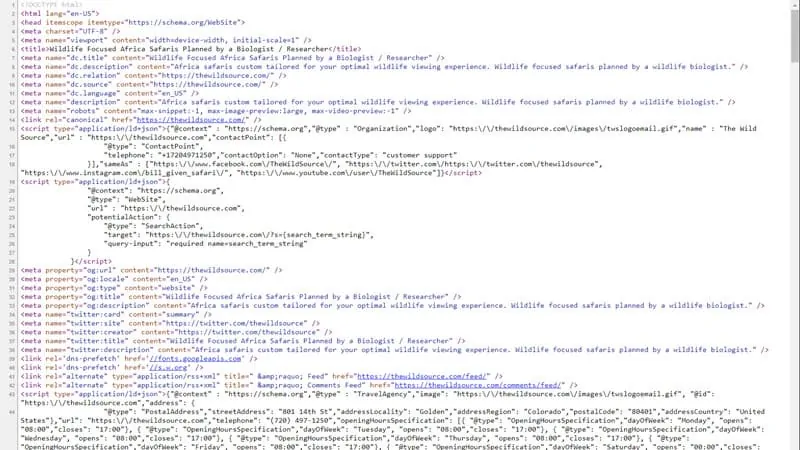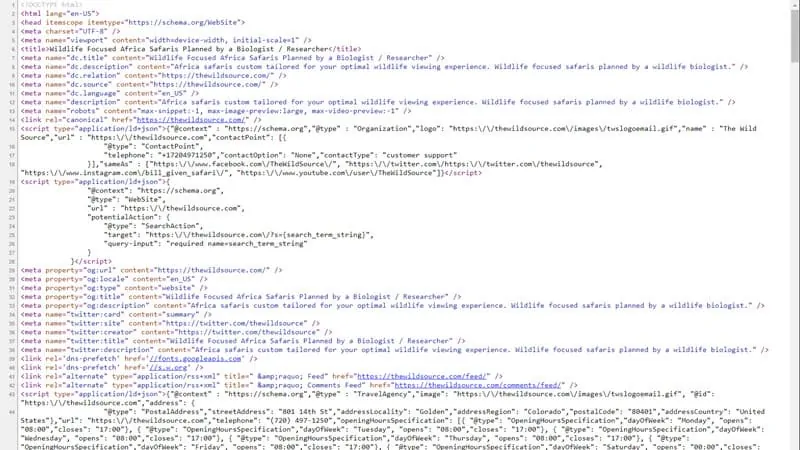What is On-Page SEO?
On-site SEO is one of the three main components of SEO – the others being content building and backlink building.
On-page SEO (as it is also called) involves making sure that your web page code and content is structured correctly for search engines like Google to understand what the web page is about easily.
Source Code Considerations for SEO
For a given web page to rank well, one of the first areas to consider is the underlying source code. The source code on your web page must be appropriately structured so that both search engines and humans conducting searches can determine the meaning of the page. The source code provides a good hint as to the content of the page.
Source code tags (described below) from a web page can appear in a variety of locations:
- View Source (in a browser)
- Search Engine Results Page
- Browser Tab

Title tags and even description tags
Source Code Tags for SEO
URL Slug
The slug is the name of your file as it appears in your browser’s address bar. The slug is the last part of the URL address. It should be unique and should describe what the web page is about.
Title Tag
The title tag appears on the current tab that you’re on in your web browser. The title tag is another signal to search engines and to users about what your web page is about.
Description Tag
A description tag isn’t believed to be used by search engines for ranking purposes. However, you must have a description tag that appeals to the person using a search engine. Your description tag may appear on the search engine results page.
Heading Tags
Heading tags are used within a web page to denote different sections of the page. Heading tags appear as h1, h2, h3… The most important heading is H1, and subheadings from H2 on down generally have less importance.
Schema Markup
Schema markup code is readable by search engines and provides the search engines with additional information about your website. As an example, for local businesses, schema markup can be used to convey address, hours, and telephone information (to name just a few properties) to search engines.

The actual content on the website is crucial from an SEO standpoint.
Content Considerations for SEO
High Quality, Rich and Engaging Content
To rank well, the content on your webpage should usually focus on a particular theme. The content must also provide excellent value to users. Superficial content on a web page that merely tries to stuff popular keywords into the page will likely not perform well.
Duplicate Content
The content on your website must be unique.
There has been talk about a “duplicate content penalty” for years. It isn’t clear whether the penalty exists, but what is clear is that pages with duplicate content are much less likely to rank well.
How duplicate content typically appears:
1) A web page on your site is similar (or the same) to a page on another website.
We often see this happen when companies employ an agency to develop their content for them. As an example, there are some marketing agencies in particular niches (dental, chiropractic, veterinary,…) who build websites for their clients that contain identical content. So the services pages and blog posts will be the same (or highly similar) for all of their clients.
The result is that from an SEO standpoint, none of these pages is likely to rank well in the search engine results.
2) A web page on your site is very similar to another page on your own site
This frequently happens when local businesses have multiple service pages that are very similar to each other. It also occurs when a business serves multiple cities – and those city pages are nearly identical.
This situation of highly similar pages greatly reduces the chances that the individual pages will rank because the content is all the same.
Some agencies will post the exact same boring blog content that no one wants to read on your site that they post on hundreds of other sites. As an example, there are dental marketing companies that will post “5 Ways to Prevent Gingivitis” to all of their clients’ blogs. This content is pointless, because it isn’t unique (it is duplicate) and no one wants to read it.
GET STARTED
Reach Us Now
Are you looking for the best On-page SEO company ? Contact us and we will not only help get you more traffic but may improve your SEO ranking as well.

